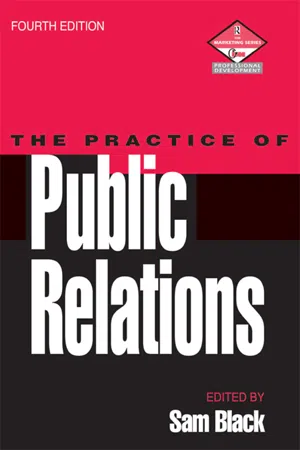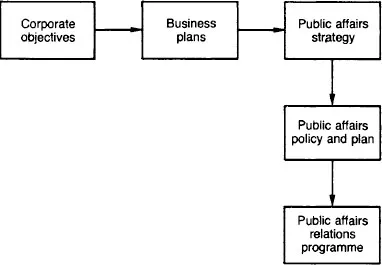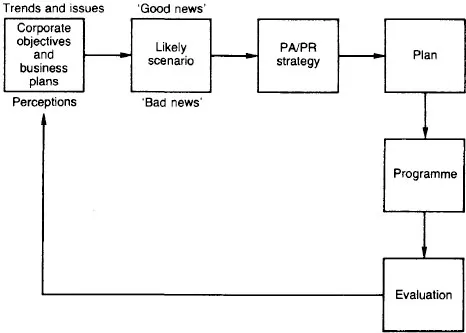
- 186 pages
- English
- ePUB (mobile friendly)
- Available on iOS & Android
eBook - ePub
Practice of Public Relations
About this book
Public relations is an essential element in effective and successful business today. The theory of public relations does not change but the practice develops with new ideas and methods of management and business. This fourth edition of 'The Practice of Public Relations' incorporates essential updating and covers new areas such as: *international public relations *crisis management *sponsorship *education and training *career prospects.
In 'The Practice of Public Relations' fifteen contributors give well-reasoned, practical introductions to every aspect of public relations. Keys to the many different ways in which public relations can contribute to the achievement of objectives and the successful and harmonious operation of an organization are given thorough coverage. T
This new edition has been prepared to embrace these changes so that CAM students and other readers are fully briefed on the latest issues in the realm of public relations.
Sam Black, during his career, has played a significant role in the development of both the Institute of Public Relations and the International Public Relations Association. Contributors: John Cole-Morgan, Betty Dean, Rosemary Graham, Mark D Grundy, Jane Hammond, Brian Harvey, Danny Moss, Margaret Nally, Phyllis Oberman, Michael Regester, Douglas Smith, Tim Travers-Healy, Neville Wade, Sue Wolstenholme.
Frequently asked questions
Yes, you can cancel anytime from the Subscription tab in your account settings on the Perlego website. Your subscription will stay active until the end of your current billing period. Learn how to cancel your subscription.
No, books cannot be downloaded as external files, such as PDFs, for use outside of Perlego. However, you can download books within the Perlego app for offline reading on mobile or tablet. Learn more here.
Perlego offers two plans: Essential and Complete
- Essential is ideal for learners and professionals who enjoy exploring a wide range of subjects. Access the Essential Library with 800,000+ trusted titles and best-sellers across business, personal growth, and the humanities. Includes unlimited reading time and Standard Read Aloud voice.
- Complete: Perfect for advanced learners and researchers needing full, unrestricted access. Unlock 1.4M+ books across hundreds of subjects, including academic and specialized titles. The Complete Plan also includes advanced features like Premium Read Aloud and Research Assistant.
We are an online textbook subscription service, where you can get access to an entire online library for less than the price of a single book per month. With over 1 million books across 1000+ topics, we’ve got you covered! Learn more here.
Look out for the read-aloud symbol on your next book to see if you can listen to it. The read-aloud tool reads text aloud for you, highlighting the text as it is being read. You can pause it, speed it up and slow it down. Learn more here.
Yes! You can use the Perlego app on both iOS or Android devices to read anytime, anywhere — even offline. Perfect for commutes or when you’re on the go.
Please note we cannot support devices running on iOS 13 and Android 7 or earlier. Learn more about using the app.
Please note we cannot support devices running on iOS 13 and Android 7 or earlier. Learn more about using the app.
Yes, you can access Practice of Public Relations by Sam Black in PDF and/or ePUB format, as well as other popular books in Business & Business General. We have over one million books available in our catalogue for you to explore.
Information
1
Public relations in Action
Before considering the way in which public relations operates, it is logical to consider the reasons why this management discipline has increased in importance under existing conditions in the political, commercial and noncommercial fields.
After discussing the rationale and methodology of public relations in this chapter, the techniques and skills used to meet specific needs and challenges will be explored in detail by other practitioners with special experience in the particular field.
Four political, social and cultural forces have been at work over the past fifty years shaping the role and the task of the public relations practitioner. These are:
1 The information debate.
2 The interdependence factor.
3 The balance philosophy.
4 Individualism.
The information debate
The information debate has raged since the early 1950s, fuelled by the demands of the returning service men and women, changes in educational systems in Europe, the campaigning of pressure and specific interest groups, the opportunism of political parties and individual politicians. Governments and national and international major institutions and corporations have had to respond.
The cry used to be 'Information is Power'. It then became 'to lack information is to be deprived' and later 'to withhold information is an infringement of personal, civil or even human rights'. The debate moved on and continues around the twin themes 'if a right to information exists then a right to communicate or respond also exists'. Furthermore, 'if people have the right to information and to communicate and respond, then they should be given the resources to respond in equal measure'.
On the international front – the United Nations and the EU – and at national levels laws now grant rights to the public and specifically to shareholders, employers, customers, legislators and administrators. These cover such items as an institution's plans and performance, financial results, job security, products and services and social impact. Laws and regulations increasingly determine not only what information must be released and when, but even the form and language in which it must be promulgated, spanning such activities as financial reports, corporate news releases, corporate print, advertising, speeches and statements and employee communication.
These changes have created a new dictionary of terms: transparency, visibility, accountability, disclosure, governance. This popular movement has meant that the task of amassing information has become more costly and time-consuming and the arranging of its release more complex. Hence the need for maximum professionalism in the information and communication field in which the 'communication explosion' is occurring.
The interdependence factor
In the 1950s and early 1960s most citizens in Europe wanted to live in a stable society in peace and prosperity. Increasingly, however, leaders in the community came to recognize that a stable society is not necessarily a static one. Moreover, in the same period vast changes of a social, political, technical, cultural and even moral nature were taking place. None could be considered in isolation, since they were interrelated. Conflicts arose as individual societies and their sub-systems were reduced, expectations were not met and disillusionment grew.
Since the late 1960s, however, a compensating belief has emerged, one based on the reality of unity. Recognition of the 'interdependence factor' as the amalgam that binds together persons, communities, nations and continents has taken hold. So has the need for institutions to consider the social impact of their decisions and activities, often a complex and professional task.
The balance philosophy
For many years business has become concerned as to whether or not the corporation as it is presently manifested will survive into the next century. If ten years ago you asked a company chairman what his objectives were, he would probably have answered 'to make a profit and to give a good return to the owners, the shareholders'. The chances are that today the modern breed of CEOs, would say cryptically, that they wanted 'to survive', or, more expansively, 'to provide a return to the shareholders, security and a future for the employees and a good product at a fair price to customers'. If prompted, some might go on to add 'to grow, to be sensitive of our community, to be a good citizen, to be socially responsible'.
The point is that in a climate of opinion wherein interdependence is recognized as a factor it is becoming increasingly accepted by modern management that its prime task is to attempt to balance the drive for profits and commercial success against corporate concern for public policies.
The pursuit of profits will not cease but it is becoming better understood that this cannot be the only objective and profits will only be attained when the organization has an acceptable public policy. Helping managers to achieve this balance is the type of task for which the experienced public relations practitioner is well fitted. Almost by definition there is almost always a conflict of interest between the various stakeholders in an enterprise. Being seen to be sensitive to that fact and endeavouring to resolve such conflicts are part of the public relations objectives.
Individualism
Forecasters differ as to what the next century will bring, but they all seem to agree that there will be a massive shift towards public concern with human values. The signs are that the focus of power is swinging away from institutions towards individuals, especially those who can use information technology and communication and can create networks to influence action. It is generally accepted today that the general public is a mythical concept. The public is made up of a series of overlapping, interlocking minorities incorporating individuals, together making up the fabric of our society.
Providing for the needs, addressing the expectations, and matching the values of these individuals is increasingly the challenge facing institutions of all sizes. Continuing to respond by mass communication alone, unrelated to information, education, participation and dialogue, will prove a snare and a delusion. Public relations practitioners, with their understanding of interactive communication and the impact of technology in this regard, will be ideally placed to aid managements to meet the challenges of the new conditions.
The methodology of public relations
The practice of public relations employs some or all of a large battery of 'tools'. With one exception, broadcasting, they have not been added to over the years. Moreover, as new techniques become available or popular, they do not push out existing practices.
The list is a long one: speeches, statements, position papers, reports, research, briefings, seminars, conferences, interviews, professional contacts, networking, community service, advertising, direct mail, broadcasting, editorial and print. It is important to realize that singly or plurally none of this long list constitutes public relations.
Public relations is why, when, where and how you use it. The temptation – even the pressures – to jump directly into action and to become 'technique-driven' must be resisted. The ideal public relations programme is proactive, not reactive.
The methodology of public relations is best expressed diagrammatically (Figure 1.1). Corporate objectives lead to shorter-term business plans, out of which, after careful assessment, a public relations strategy can be determined. While it has been stressed that ideally public relations will be proactive and programmed, it is true every day that reactive measures may become necessary to meet emergencies or harmful criticism.
The scheme shown in Figure 1.1 is developed further in Figure 1.2. Corporate objectives and business plans tend to be handed down at a fixed point in the corporate planning cycle. But the objectives can only be attained if they have been analysed in the light of political and social trends, changing issues, and the perceptions of the relevant sections of the public. It is through a study of public or group perceptions that it is possible to gauge the amount of understanding and support a company is likely to receive for its plans and performance.

Figure 1.1 Methodology of public relations

Figure 1.2 Public relations methodology elaborated
Issues management
This may appear to be a formidable title but Abraham Lincoln summed it up very neatly: 'If we could first know where we are and whither we are tending we could better judge what to do and how to do it'.
The term 'issues management' was first coined in 1977 by Howard Chase in the United States but the concept is not new. The following working definition explains its relevance: 'Issues management is identifying, analysing, developing positions, and briefing management on public policy issues that will have a critical effect on the company'. The critical point to note in this definition is its emphasis on the future. Issues management is concerned with forecasting the likely impact of issues and advising management on how to respond to them.
Perceptions
One must not lose sight of the basic factor, the public, without whom there would be no issues. It is through a study of perceptions held by relevant sections of the public that it is possible to gauge the s...
Table of contents
- Front Cover
- Half Title
- Books in the Series
- Title Page
- Copyright
- Contents
- List of Illustrations
- List of Contributors
- Preface to the fourth edition
- Introduction
- 1 Public relations in action
- 2 Media relations
- 3 Other media of public relations - exhibitions, words and images
- 4 Public affairs and corporate relations
- 5 Public relations and marketing
- 6 Public relations in central government
- 7 Public relations in local government
- 8 Public relations in the non-commercial sector
- 9 Parliamentary relations and lobbying
- 10 Consultancy public relations
- 11 Ethics and codes of professional conduct
- 12 Legal aspects of public relations practice
- 13 International public relations
- 14 Crisis management
- 15 Sponsorship
- 16 Education, training and career prospects
- Index